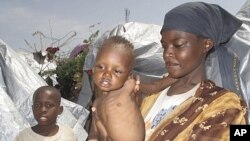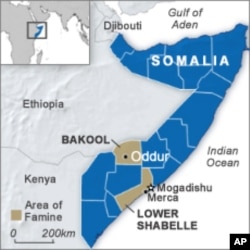An international aid agency said a massive and immediate humanitarian response is needed to save the lives of millions of Somalis who are at risk of hunger and disease because of the ongoing drought in the Horn of Africa.
|
Definition of Famine: The word famine is a term that is not used lightly by humanitarian organizations. The United Nations describes a crisis as a famine only when the following conditions are met:
Current Famine:
|
The International Rescue Committee (IRC) said aid should be increased to match the scale of the disaster.
Zoe Daniels, deputy director of programs for the Horn of Africa, said an aggressive and global mobilization of emergency aid is required.
“The scale of the disaster in the Horn of Africa, especially Somalia, Ethiopia and Kenya is huge, and so the funds that need to be mobilized need to be massive and immediate to be able to save the lives of millions of Somalis that are at risk of hunger and disease,” she said.
Daniels said the international response should go beyond just food aid.
“You’ve got over 11 million people at risk in this area – Kenya, Somalia, and Ethiopia – including refugees that have moved from Somalia, and there needs to be a huge response in terms of the level of funds that are provided, and there also needs to be access to meet the people’s needs,” Daniels said.
She said the International Rescue Committee has been responding to the crisis from its onset several months ago.
“The International Rescue Committee has been providing support in both Dadaab Camp in Kenya and the camps in Dolo Odo in southern Ethiopia. In Ethiopia, we are providing water in several of the camps, and in Dadaab we’re providing health services; we’re helping with screening as people arrive from Somalia,” she said.
The U.N. this week declared a famine in southern Somalia's Bakool and Lower Shabelle regions, both strongholds of the al-Qaida-linked militant group al-Shabab. Al-Shabab recently allowed some foreign aid agencies into the region, reversing a ban on most relief groups.
Daniels said the International Rescue Committee has been delivering aid in parts of Somalia, although she said security concerns remain.“In central Somali we do have access; we have a very dedicated staff of Somalis working for us in central Somalia, and we are able to access the area and to send in support to our teams there," she said. "However in other parts of Somalia, the security situation is very difficult, and we are not able to access the areas.".















